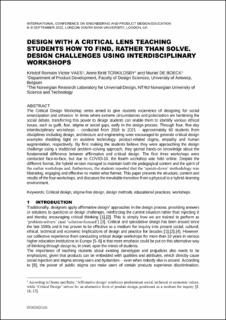DESIGN WITH A CRITICAL LENS TEACHING STUDENTS HOW TO FIND, RATHER THAN SOLVE, DESIGN CHALLENGES USING INTERDISCIPLINARY WORKSHOPS
Chapter
Published version

View/
Date
2022Metadata
Show full item recordCollections
- Institutt for design [1086]
- Publikasjoner fra CRIStin - NTNU [37703]
Original version
10.35199/EPDE.2022.2Abstract
The Critical Design Workshop series aimed to give students experience of designing for social emancipation and cohesion. In times where extreme circumstances and polarization are hardening the social debate, transferring this power to design students can enable them to identify various ethical issues, such as guilt, fear, stigma or social gaps, early in the design process. Through four, five-day interdisciplinary workshops – conducted from 2018 to 2021 – approximately 60 students from disciplines including design, architecture and engineering were encouraged to generate critical design examples shedding light on assistive technology, product-related stigma, empathy and human augmentation, respectively. By first making the students believe they were approaching the design challenge using a traditional problem-solving approach, they gained hands-on knowledge about the fundamental difference between affirmative and critical design. The first three workshops were conducted face-to-face, but due to COVID-19, the fourth workshop was held online. Despite the different format, the hybrid version managed to maintain both the pedagogical content and the spirit of the earlier workshops and, furthermore, the students reported that the ‘upside-down’ methodology was liberating, engaging and effective no matter what format. This paper presents the structure, content and results of the four workshops, and discusses the inevitable transition from a physical to a hybrid-learning environment